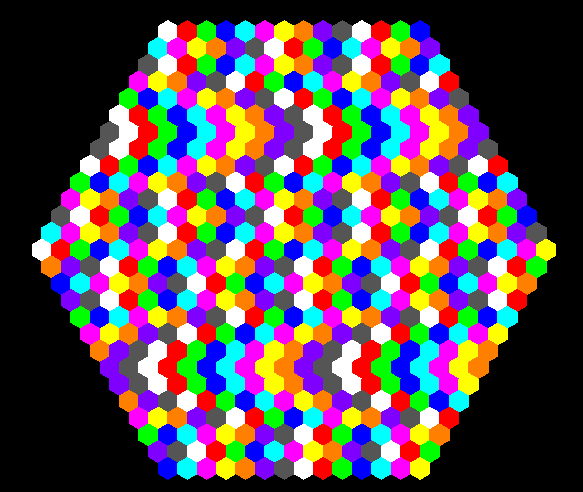Geometry of the LIFU fibre array
The Large Integral-Field Unit (LIFU) comprises a hexagonal array of 547
2.6-arcsec fibres plus, at a radius from the centre of ~ 150 arcsec, the 8 outlying
sky-fibre bundles (7 fibres each), i.e. a total of
547 + 56 = 603 2.6-arcsec fibres.
The main components can be seen in
the photo below (taken by Javier Mendez in May 2022, click for full
size), where each fibre is back-illuminated from the spectrograph.
Note that a few of the fibres near the
edge of the LIFU array are displaced
(and a few fibres in the main array have
much-reduced transmission).

The core diameter of each fibre is 170 micron. With cladding and buffering,
the centre-to-centre separations of the fibres are 220 micron.
The focal-plane scale at the LIFU fibre array itself
(after an intervening optic)
is 15.4 arcsec mm-1, so on-sky the fibre diameters are 2.6 arcsec
(and the areas 5.3 arcsec2),
and the centre-to-centre separations are 3.4 arcsec.
The fibres in the main array are held in place with
the aid of a buffer of additional cirmcumferential fibres.
These circumferential fibres are not illuminated.
The hexagonal shape of the fibre array is a compromise between tileability,
and suitability for typical targets. Circles don't tile efficiently.
Hexagons and rectangles do. Rectangles are less
well-suited to the typical ~ circular symmetry of many extended targets.
The LIFU fibres are
numbered, in the range 1 - 609, according to position along the pseudo-slit
in the spectrograph.
The first fibre (smallest y on the detector) is number 1.
The last is 609, this number being the product of
29, the number of slitlets, and 21, the maximum (and typical)
number of fibres per
slitlet.
The locations of the fibres within the science array (mount PA = 0,
x,y provided by Jure Skvarc)
are shown below.
The fibre numbers are coloured according to slitlet number (see next paragraph).
The fibres circled in
red (155, 520 and 577) are missing on the detector (i.e. are not
transmitting light, as can be seen on the image above).
The scale at the LIFU array is 15.8 arcsec/mm.
The central fibre (#305) is circled in blue, and it's 6 immediate neighbours
(i.e. the fibres on which some light may fall when observing
a bright star centred on #305) are
#283, 279, 300, 327, 353, 330. All 7 fibres are on slitlets 14 - 17.

The graphic below is similar, but the label is slit number
(1 - 29) rather than fibre number. The fibres of a given slitlet
are labelled in the same colour (NB each colour is used for
more than one slitlet). The graphic shows
how individual slitlets typically sample a small
contiguous area of the focal plane, but with a few distributed
across the rest of the array
(or in the sky-fibre bundles, not shown here).

For a similar graphic showing 'fibre number along the slitlet' (i.e. 1 - 21),
click
here.
Fibre number along the slitlet is uncorrelated with x,y position on the array.
The location of the corresponding spectra on the detector is described on
a separate page.
The LIFU fibres are an example of a
regular hexagonal array, with side N = 14 (click on figure for
enlargement):

The central fibre is coloured dark blue on this representation.
The number of elements in the main LIFU array, 547, is the 14th centred
hexagonal number NC(N) = 3N (N-1) + 1 for N = 14. The width-to-height
ratio (formula on the above link) is 1.14.
For a large array of circular apertures of diameter
A, with centre-to-centre separation B, the filling factor is given by
(A/B)2 x pi / 2 / sqrt(3).
The filling factor of LIFU is therefore approximately 55%.
For A = B (apertures touching) the filling factor would have been 0.91.
Chris Benn, Lilian Domínguez, Cecilia Fariña
Back to LIFU home page

